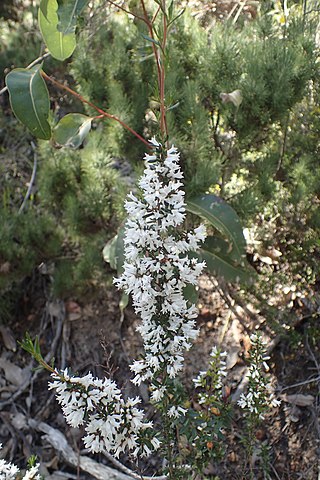
Cryptandra arbutiflora, commonly known as waxy cryptandra, is a species of flowering plant in the family Rhamnaceae and is endemic to the southwest of Western Australia. It is a shrub with spiny branches, elliptic to linear leaves and tube-shaped white flowers.
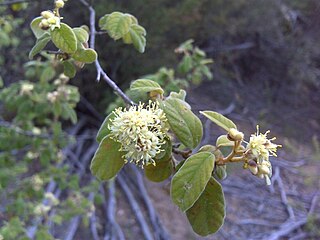
Pomaderris subcapitata is a species of flowering plant in the family Rhamnaceae and is endemic to south-eastern continental Australia. It is a shrub with hairy stems, elliptic to egg-shaped leaves and dense clusters of cream-coloured or yellow flowers.
Spyridium glaucum is a species of flowering plant in the family Rhamnaceae and is endemic to a restricted area of south-western Western Australia. It is an erect or spreading shrub with egg-shaped leaves, and clusters of 3 to 6 rusty-hairy flowers.
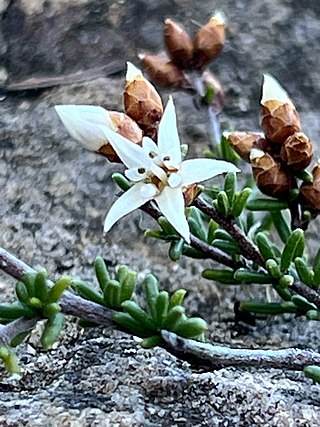
Cryptandra aridicola is a flowering plant in the family Rhamnaceae and is endemic to inland areas of Western Australia. It is a small, spreading shrub with white or pink flowers.
Spyridium minutum is a species of flowering plant in the family Rhamnaceae and is endemic to the south of Western Australia. It is an erect or spreading shrub with broadly egg-shaped or heart-shaped leaves, and groups of two or three hairy, white flowers.
Spyridium montanum is a species of flowering plant in the family Rhamnaceae and is endemic to the Stirling Range in the south of Western Australia. It is an erect shrub with elliptic or egg-shaped leaves, and groups of up to ten densely hairy, white or cream-coloured flowers.
Spyridium mucronatum is a species of flowering plant in the family Rhamnaceae and is endemic to the south of Western Australia. It is an erect or spreading shrub usually with narrowly oblong leaves, and dense clusters of up to ten densely hairy, white to yellow flowers.
Cryptandra beverleyensis is a species of flowering plant in the family Rhamnaceae and is endemic to the southwest of Western Australia. It is a shrub with narrowly oblong leaves and clusters of white, tube-shaped flowers.
Cryptandra congesta is a flowering plant in the family Rhamnaceae and is endemic to a restricted area of the south-west of Western Australia. It is a low, spreading shrub with narrowly egg-shaped or narrowly oblong leaves and clusters of white, tube-shaped flowers.
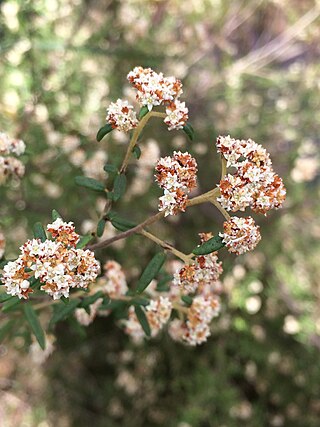
Spyridium riparium is a species of flowering plant in the family Rhamnaceae and is endemic to the south of Western Australia. It is an erect shrub, usually with narrowly egg-shaped leaves, and clusters of densely hairy, white or cream-coloured flowers.
Cryptandra craigiae is a flowering plant in the family Rhamnaceae and is endemic to a restricted area of southern Western Australia. It is a shrub with linear leaves and dense clusters of white or cream-coloured, tube-shaped flowers.
Cryptandra dielsii is a flowering plant in the family Rhamnaceae and is endemic to the south-west of Western Australia. It is a spreading shrub with linear to narrowly oblong leaves and dense clusters of white, hairy, tube-shaped flowers.
Cryptandra distigma is a flowering plant in the family Rhamnaceae and is endemic to inland Western Australia. It is a shrub with oblong or narrowly egg-shaped leaves and clusters of white to cream-coloured, tube-shaped flowers.
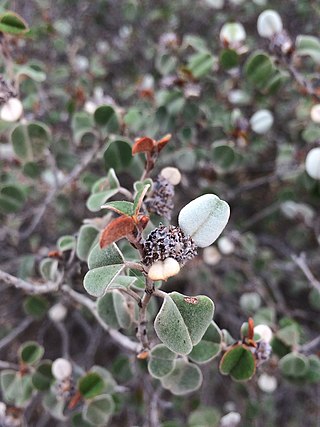
Spyridium tricolor is a species of flowering plant in the family Rhamnaceae and is endemic to southern continental Australia. It is an erect shrub with broadly elliptic to round leaves, and dense clusters of densely woolly-hairy, cream-coloured flowers.
Cryptandra exserta is a flowering plant in the family Rhamnaceae and is endemic to inland Western Australia. It is a shrub with narrowly oblong leaves and clusters of white, tube-shaped flowers.
Stenanthemum arens is a species of flowering plant in the family Rhamnaceae and is endemic to South Australia. It is a twiggy shrub with broadly egg-shaped to almost circular leaves and heads of 10 to 20 silky-hairy white, tube-shaped flowers, usually with whitish floral leaves.
Stenanthemum argenteum is a species of flowering plant in the family Rhamnaceae and is endemic to a restricted part of Queensland. It is a shrub with hairy branches, lance-shaped to egg-shaped leaves with the narrower end towards the base, and heads of about seven hairy white, tube-shaped flowers.
Cryptandra graniticola is a flowering plant in the family Rhamnaceae and is endemic to southern Western Australia. It is an upright, spreading shrub with spiny branchlets, linear to narrowly egg-shaped leaves and clusters of white, tube-shaped flowers.
Stenanthemum centrale is a species of flowering plant in the family Rhamnaceae and is endemic to the Northern Territory of Australia. It is a woody shrub with egg-shaped leaves, the narrower end towards the base and dense, yellowish heads of 10 to 40 tube-shaped flowers, sometimes with whitish floral leaves.
Stenanthemum complicatum is a species of flowering plant in the family Rhamnaceae and is endemic to the southwest of Western Australia. It is a woody, erect or straggling shrub with densely hairy young stems, broadly egg-shaped leaves and densely woolly-hairy heads of tube-shaped flowers.





